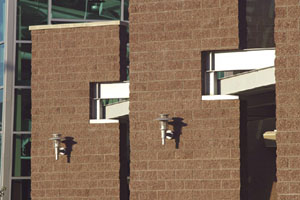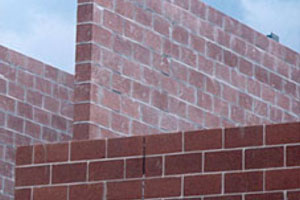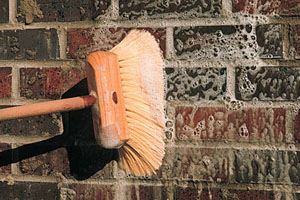Getting the Most from Admixtures
By Brett Martin

Masonry admixtures have many advantageous properties, from activating or retarding the mortar's setting time, to repelling water and controlling efflorescence; increasing weather resistance, to protecting mortar color. But they have to be used correctly to work effectively.
Masonry experts emphasize the importance of following recommended guidelines when using admixtures. In particular, they cite ASTM C 1384, the Standard Specification for Admixtures for Masonry Mortars, which provides criteria for evaluating admixtures for use in masonry mortars.
Manufacturers' specifications also are important, said Jeff Leonard, vice president of bulk materials for The QUIKRETE Companies in Atlanta. "Masons have to follow all manufacturers' directions when using admixtures," he said. "They have to be very cognizant of those directions."
Neal Jablonski, technical service specialist for masonry products for Cambridge, Mass.-based Grace Construction Company, agreed, saying mason contractors should also check with manufacturers' suppliers for their recommendations. "Admixture suppliers ought to be consulted for proper mixing procedures," he said.

When using an accelerator, crews need to follow the cold weather practice of using hot water in the mixture, Leonard said. The hot water activates the accelerator; without it, the admixture may not work correctly.
Jablonski said that, in addition to using hot water with accelerators, mason contractors sometimes heat the sand and cement for the mixture.
To the opposite end of the spectrum, retarders slow the rate of hydration in warm weather, keeping the mortar workable for a longer period of time. Leonard said he's seen masons using ice with the mixture in hot weather to aid the retarder.
He advised mixing smaller batches of mortar when the temperature climbs to keep it from setting too soon. "Mortar will tend to 'flash set' in hot weather," Leonard said. "You want to mix small batches. It's easier to control a smaller amount."
A severe change in temperature at the job site can impact the admixture, Leonard explained. Crews need to be aware of the amount of admixture they're using and the specifications for that day's temperature.
"If they're adding an accelerant, and consistently adding it for a few days, and then they get a warm day, it may change the characteristics of the accelerant," he said. "They have to be cognizant of that."
Temperatures also are a factor in storing admixtures. Their degradation is increased when exposed to heat and direct sunlight, while temperatures below 32 degrees Fahrenheit may cause the admixture chemicals to crystallize.
"Some admixtures added to the mortar in the field are liquid," Leonard said. "When [the temperature falls] below freezing, you have to take extra care so it doesn't freeze. You can't just leave it out at the job site to use the next day."

Pre-blended admixtures help keep the mortar consistent, said Nick Blohowiak, regional manager for Mendota Heights, Minn.-based SPEC MIX. "The key to successful admixture use in masonry is to control and keep consistent the admixture you're using," he said. "The benefit of pre-blended is you always know the admixture is in there in the proper dosage."
While pre-blended admixtures have their advantages, mason contractors and their crews still need to adhere to established guidelines when using them.
"Even with pre-blended mixes, they still have to follow masonry practices. One of the fallacies is you don't have to follow the same rules," Leonard said. "If you're mixing in cold weather, below freezing, with a pre-blend, you still have to use warm water, and you have to keep the wall protected from freezing."
When mixing a pre-blended mortar that has an accelerator in temperatures below 40 degrees Fahrenheit, mason contractor crews need to heat the water to between 40 and 120 degrees, just like they would if they were adding the admixture themselves, he said.
"None of these admixtures creates short cuts," Leonard said.
There are, however, admixtures that are easily added in the field. The key to mixing them into the mortar on the job site is to add them right after putting in the water, before the sand and cement are added. This allows the admixture to mix evenly in the batch.
"You want the admixture dispensed evenly throughout the water," Leonard said.
The drawback to laborers adding the admixtures themselves is that they can miscalculate how much is needed, which results in an inconsistent amount per batch, he said. This can change the tooling characteristics or make the mortar color slightly lighter or darker.
"If it's not consistent, it can show up on the finished, tooled wall," Leonard said. "More importantly, if you tool the joints too early, the color may be lighter. If you tool later, the color may be darker."

"They go hand in hand. The efflorescence benefit that you get is due to the water repellency," Jablonski said. "A water repellant also offers efflorescent control."
SPEC MIX's Integral Water Repellent (IWR) is a pre-blended mortar mix that contains a water repellant admixture and controls efflorescence. "It's a standard mortar, and we added the admixture," Blohowiak said. "IWR helps the mortar physically repel the water."
Hycrete Incorporated in Jersey City, N.J., offers a water-based liquid admixture that's mixed in the field and forms a waxy residue to prevent water penetration into the finished wall.
"It forms a chemical bond to metals in the concrete. It makes the joints water tight," said David Rosenberg, CEO of Hycrete. He added that, although the admixture is mostly used on concrete walls, it could also be used in masonry mortar mixes.
BASF Admixtures Inc., in Cleveland, which acquired Degussa's construction chemicals business in July 2006, offers one water repellent admixture for concrete block and another for masonry mortar. The admixtures have a polymer additive that increases the color integrity.
"Rheopel WR admixture enables the production of visually appealing concrete masonry products that are water-penetration resistant and efflorescence-controlled," according to the company. "This unique, patented formula incorporates a specially blended, high-molecular weight, polymer emulsion that improves and maintains color integrity."
While new innovations are giving water repellant admixtures increased compressive strength, more durability and decreased absorption rates, QUIKRETE's Leonard warned that the reduced water-to-cement ratio of these admixtures is not necessarily a good idea since they can make the mortar too strong.
"An owner or architect may be sold on the idea that stronger is better, particularly concerning mortar and masonry unit strength. However, you always want the mortar to be weaker than the masonry units themselves," Leonard said. "While you never want a wall to crack, if unavoidable, it is best to have the mortar absorb the stress and crack as opposed to the brick, stone or block. Mortar is far less costly a repair than replacing or repairing cracks in the masonry unit."

"When cleaned to reveal the original intended appearance, it's hard to come up with a better looking exterior for a building than masonry," said Gary Henry, business communications specialist for PROSOCO, in Lawrence, Kan., which makes cleaning products for masonry walls. "If the cleaner is not used correctly, the opposite is true. You can ruin the job beyond repair. Careers have been ruined and fortunes lost because of this."
The possible combinations of masonry, mortar-type, admixtures and cleaners are practically unlimited, Henry said. Therefore, the best practices are to only use cleaners from a reputable company that backs up its products, and to test the cleaner on a small, out of the way area before cleaning the entire wall. Changes in the dilution rate or dwell time may solve any problems. If not, mason contractors should consult the cleaner manufacturer.
"There are many kinds of admixtures for many different purposes. Some may react with certain types of cleaners to cause stains. Other admixtures may make excess mortar more difficult to remove. Still other admixtures may make the mortar easier to remove," Henry said. "Complicating the matter is the type of masonry used. A concrete masonry, for instance, with an admixture that makes the mortar more difficult to remove could be problematic, since concrete masonries may be etched by more powerful cleaners, stronger dilutions or longer dwell times."
Jablonski suggested admixture manufacturers should play a role by explicitly stating recommended cleaning guidelines to eliminate potential problems. "For us, it's a good rule of thumb to specify the cleaning procedure," he said.
As long as mason contractors and their crews use the right tool — in this case, the right cleaner — for the job, they won't have any problems, Henry said.
"We make products that address the qualities of each specific substrate," he said, noting that brick, block and stone each have their own qualities, so they need their own cleaners. "If you're smart, you'll use the most specific tool you can. The real, true professional people understand that you need the right product for the right job."
About the Author
Brett Martin is a freelance writer located in Shakopee, Minn. with several years of construction and writing experience.


















